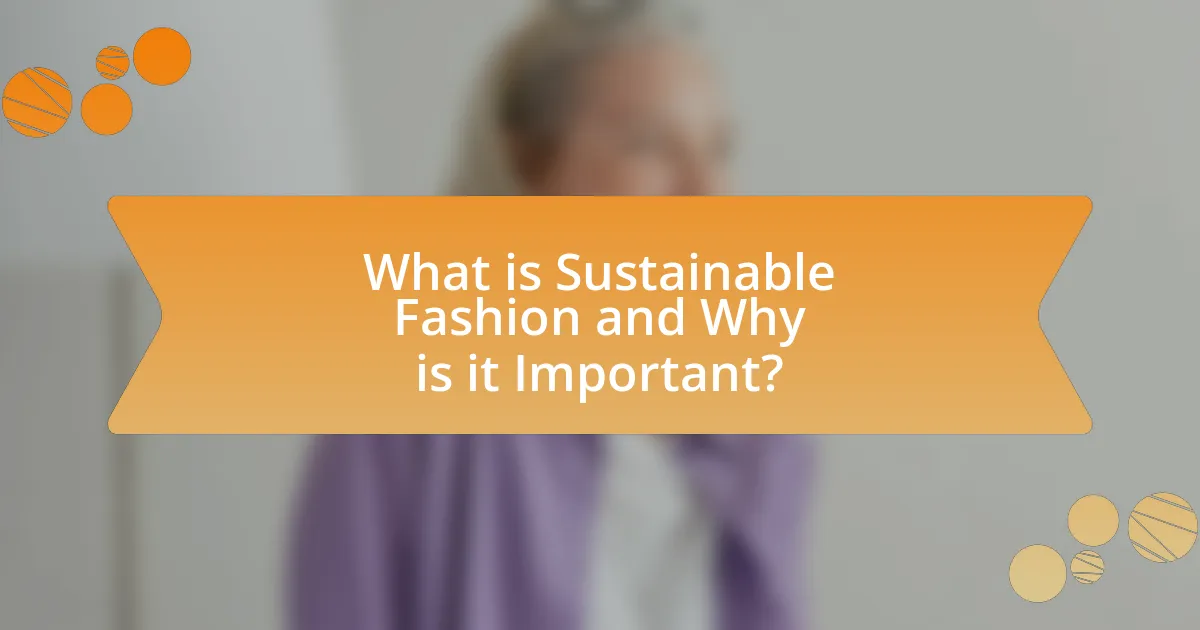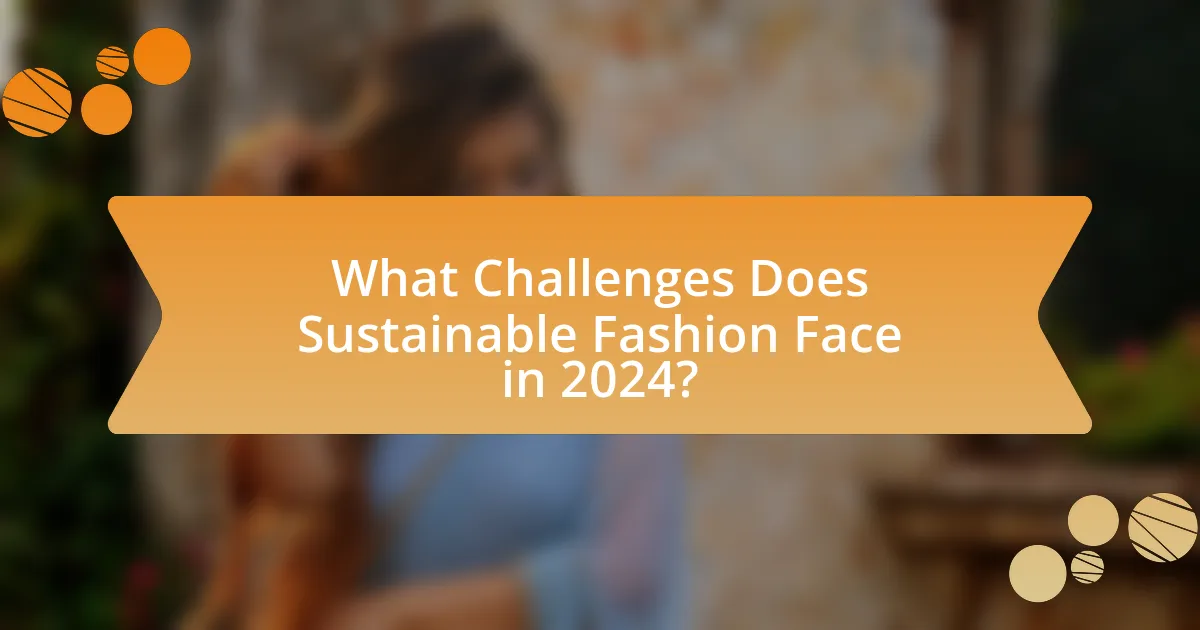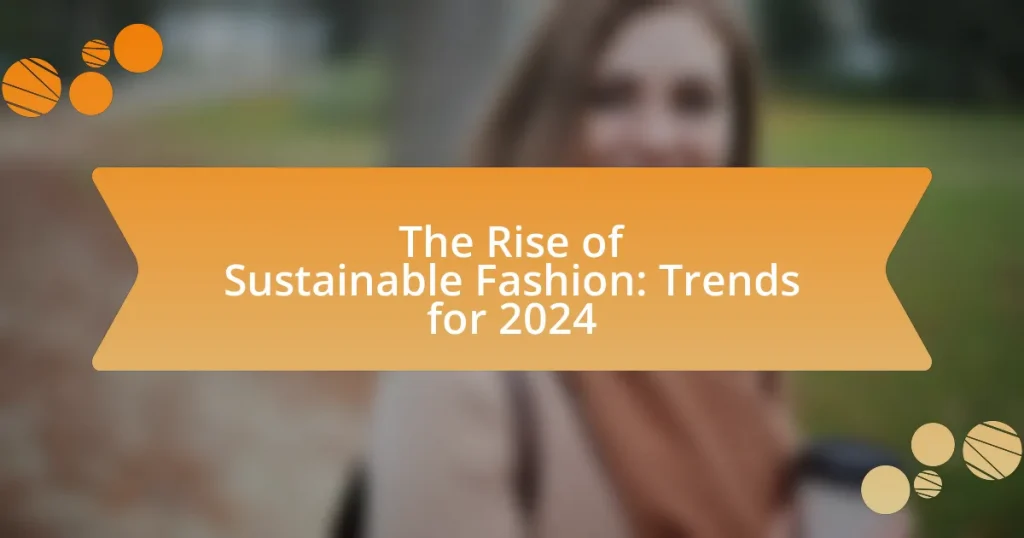The article focuses on the rise of sustainable fashion and its trends for 2024, highlighting the importance of environmentally friendly and socially responsible practices in the fashion industry. It discusses the evolution of sustainable fashion, influenced by historical events and changing consumer attitudes, emphasizing key principles such as ethical production, resource efficiency, and circularity. The article also examines emerging trends, innovations in materials and technology, and the challenges faced by the industry, including high production costs and consumer awareness. Additionally, it outlines practical steps consumers can take to support sustainable fashion, reinforcing the role of informed choices in promoting eco-friendly practices.

What is Sustainable Fashion and Why is it Important?
Sustainable fashion refers to clothing and accessories produced in environmentally friendly and socially responsible ways, prioritizing the reduction of waste, pollution, and resource consumption. It is important because the fashion industry is one of the largest polluters globally, contributing to significant environmental degradation and social injustices, such as poor labor conditions. According to the United Nations, the fashion industry accounts for about 10% of global carbon emissions and is the second-largest consumer of the world’s water supply. By adopting sustainable practices, the industry can mitigate its negative impact, promote ethical labor practices, and encourage consumers to make more informed choices, ultimately leading to a healthier planet and society.
How has the concept of sustainable fashion evolved over time?
The concept of sustainable fashion has evolved from a niche concern in the 1960s and 1970s to a mainstream movement by the 2020s. Initially, sustainable fashion focused on ethical labor practices and the use of organic materials, as seen in early initiatives like the Organic Exchange founded in 2002, which promoted organic cotton. Over time, the movement expanded to include environmental impacts, such as reducing waste and carbon footprints, driven by awareness of climate change and resource depletion. By the 2010s, brands began adopting circular economy principles, emphasizing recycling and upcycling, with notable examples like Patagonia’s Worn Wear program. As of 2023, sustainable fashion encompasses a broader range of practices, including transparency in supply chains and the use of innovative materials like bio-fabricated textiles, reflecting a significant shift towards holistic sustainability in the fashion industry.
What historical events have influenced the rise of sustainable fashion?
The rise of sustainable fashion has been significantly influenced by several historical events, including the Industrial Revolution, the 1960s counterculture movement, and the 2013 Rana Plaza disaster. The Industrial Revolution marked a shift towards mass production, leading to environmental degradation and labor exploitation, which sparked early awareness of sustainability issues. The 1960s counterculture movement emphasized anti-consumerism and environmental consciousness, promoting a shift towards more ethical consumption. The Rana Plaza disaster, where a garment factory collapsed in Bangladesh, killing over 1,100 workers, highlighted the urgent need for ethical labor practices and sustainability in the fashion industry, prompting widespread advocacy for reform and responsible sourcing. These events collectively catalyzed the sustainable fashion movement, driving consumer demand for transparency and ethical practices in the industry.
How do consumer attitudes towards fashion impact sustainability?
Consumer attitudes towards fashion significantly impact sustainability by influencing purchasing decisions and brand loyalty. When consumers prioritize sustainability, they tend to support brands that adopt eco-friendly practices, such as using organic materials or implementing fair labor standards. For instance, a 2021 survey by McKinsey & Company found that 67% of consumers consider sustainability when making fashion purchases, indicating a strong preference for brands that demonstrate environmental responsibility. This shift in consumer behavior encourages companies to adopt sustainable practices, ultimately leading to reduced waste and lower carbon footprints in the fashion industry.
What are the key principles of sustainable fashion?
The key principles of sustainable fashion include ethical production, resource efficiency, and circularity. Ethical production emphasizes fair labor practices and transparency in the supply chain, ensuring that workers are treated fairly and compensated adequately. Resource efficiency focuses on minimizing waste and using sustainable materials, such as organic cotton or recycled fabrics, to reduce environmental impact. Circularity promotes the idea of designing products for longevity and recyclability, encouraging consumers to recycle or upcycle garments rather than discarding them. These principles collectively aim to create a fashion industry that is environmentally responsible and socially equitable.
How does sustainable fashion address environmental concerns?
Sustainable fashion addresses environmental concerns by promoting eco-friendly materials and ethical production practices. This approach reduces waste and pollution associated with traditional fashion, which is responsible for significant environmental degradation; for instance, the fashion industry contributes to 10% of global carbon emissions and is a major source of water pollution. By utilizing organic fabrics, recycling materials, and implementing sustainable manufacturing processes, sustainable fashion minimizes its ecological footprint and encourages a circular economy, where products are reused and recycled rather than discarded.
What social issues does sustainable fashion aim to resolve?
Sustainable fashion aims to resolve several social issues, primarily labor exploitation, environmental degradation, and consumerism. Labor exploitation is addressed by promoting fair wages and safe working conditions for garment workers, as evidenced by initiatives like the Fair Trade certification, which ensures ethical labor practices. Environmental degradation is tackled through the use of eco-friendly materials and sustainable production methods, reducing the fashion industry’s carbon footprint. Additionally, sustainable fashion seeks to combat consumerism by encouraging mindful consumption and promoting the value of quality over quantity, as highlighted by the growing popularity of capsule wardrobes and second-hand shopping.

What are the Major Trends in Sustainable Fashion for 2024?
The major trends in sustainable fashion for 2024 include increased use of biodegradable materials, a focus on circular fashion, and the rise of digital fashion. Biodegradable materials, such as organic cotton and hemp, are gaining traction as brands seek to reduce environmental impact. Circular fashion emphasizes recycling and upcycling, encouraging consumers to participate in sustainable practices by extending the lifecycle of garments. Additionally, digital fashion is emerging as a trend, with virtual clothing and accessories allowing for sustainable consumption without physical production. These trends reflect a growing consumer demand for environmentally responsible practices in the fashion industry.
How are brands innovating to promote sustainability in 2024?
Brands are innovating to promote sustainability in 2024 by integrating advanced technologies and sustainable materials into their production processes. For instance, companies are increasingly utilizing biodegradable fabrics and recycled materials, which significantly reduce environmental impact. According to a report by McKinsey & Company, 67% of fashion brands are investing in sustainable materials to meet consumer demand for eco-friendly products. Additionally, brands are adopting circular economy principles, such as take-back programs and upcycling initiatives, to extend the lifecycle of their products. This shift not only addresses waste but also aligns with consumer preferences for sustainable practices, as highlighted by a survey from Deloitte indicating that 32% of consumers prioritize sustainability in their purchasing decisions.
What new materials are being used in sustainable fashion?
New materials being used in sustainable fashion include organic cotton, Tencel, recycled polyester, and innovative bio-based fabrics such as Piñatex and Mylo. Organic cotton is cultivated without synthetic pesticides, reducing environmental impact. Tencel, made from sustainably sourced wood pulp, is biodegradable and produced in a closed-loop process that recycles water and solvents. Recycled polyester, derived from post-consumer plastic bottles, diverts waste from landfills and reduces reliance on virgin materials. Piñatex, made from pineapple leaf fibers, and Mylo, derived from mycelium, offer alternatives to leather, promoting animal welfare and reducing resource consumption. These materials reflect a growing trend towards eco-friendly practices in the fashion industry.
How are technology and sustainability intersecting in fashion?
Technology and sustainability are intersecting in fashion through innovations such as digital design, sustainable materials, and supply chain transparency. Digital design tools enable brands to create virtual prototypes, reducing waste associated with physical samples. Sustainable materials, like bio-based fabrics and recycled textiles, are being developed using advanced technologies, which minimize environmental impact. Additionally, technologies like blockchain enhance supply chain transparency, allowing consumers to verify the sustainability of their purchases. For instance, a report by McKinsey & Company highlights that 67% of consumers consider sustainability when making fashion purchases, indicating a growing demand for eco-friendly practices driven by technological advancements.
What role do consumers play in shaping sustainable fashion trends?
Consumers play a crucial role in shaping sustainable fashion trends by driving demand for eco-friendly products and practices. Their purchasing decisions increasingly favor brands that prioritize sustainability, leading to a shift in the fashion industry towards more responsible production methods. For instance, a 2021 survey by McKinsey & Company found that 67% of consumers consider the use of sustainable materials important when making fashion purchases. This consumer preference influences brands to adopt sustainable practices, such as using organic fabrics and reducing waste, thereby reinforcing the trend towards sustainability in fashion.
How can consumer choices influence brand practices?
Consumer choices significantly influence brand practices by driving companies to adopt sustainable and ethical methods in response to demand. As consumers increasingly prioritize sustainability, brands are compelled to implement eco-friendly materials, reduce waste, and enhance transparency in their supply chains. For instance, a 2021 survey by McKinsey & Company found that 67% of consumers consider sustainability when making a purchase, prompting brands to shift towards more responsible practices to meet these expectations. This shift not only aligns with consumer values but also enhances brand loyalty and market competitiveness.
What are the emerging consumer demands for sustainable fashion?
Emerging consumer demands for sustainable fashion include a strong preference for eco-friendly materials, transparency in supply chains, and ethical labor practices. Consumers increasingly seek clothing made from organic, recycled, or biodegradable materials, reflecting a growing awareness of environmental impact. Additionally, they demand brands to disclose their sourcing and manufacturing processes, as studies show that 66% of consumers are willing to pay more for sustainable brands. Ethical labor practices are also crucial, with consumers favoring companies that ensure fair wages and safe working conditions. This shift is driven by a desire for accountability and a commitment to social responsibility in the fashion industry.

What Challenges Does Sustainable Fashion Face in 2024?
Sustainable fashion faces significant challenges in 2024, primarily including high production costs, supply chain transparency issues, and consumer awareness. High production costs arise from the use of eco-friendly materials and ethical labor practices, which can lead to higher retail prices that deter price-sensitive consumers. Supply chain transparency remains a critical issue, as many brands struggle to trace the origins of their materials and ensure ethical practices throughout their supply chains. Additionally, consumer awareness is often limited, with many shoppers still prioritizing fast fashion due to its affordability and accessibility, making it difficult for sustainable brands to compete. These challenges hinder the growth and acceptance of sustainable fashion in the mainstream market.
What are the barriers to widespread adoption of sustainable practices?
The barriers to widespread adoption of sustainable practices include high costs, lack of consumer awareness, and insufficient infrastructure. High costs deter both consumers and businesses from choosing sustainable options, as many eco-friendly products are priced higher than conventional alternatives. Lack of consumer awareness limits demand for sustainable practices, with many individuals unaware of the environmental impact of their choices. Insufficient infrastructure, such as limited recycling facilities and inadequate supply chains, hampers the implementation of sustainable practices. According to a 2021 report by McKinsey & Company, 66% of consumers expressed a willingness to pay more for sustainable products, yet only 27% actively seek them out, highlighting the gap between awareness and action.
How do economic factors impact sustainable fashion initiatives?
Economic factors significantly influence sustainable fashion initiatives by determining the availability of resources, consumer purchasing power, and market demand for eco-friendly products. For instance, when economic conditions are favorable, consumers are more likely to invest in sustainable fashion, as evidenced by a 2021 McKinsey report indicating that 67% of consumers consider sustainability when making a purchase. Conversely, during economic downturns, consumers often prioritize cost over sustainability, leading to decreased demand for sustainable options. Additionally, the cost of sustainable materials and production processes can impact the pricing of sustainable fashion, affecting its competitiveness in the market. Thus, economic factors play a crucial role in shaping the viability and growth of sustainable fashion initiatives.
What misconceptions exist about sustainable fashion?
Misconceptions about sustainable fashion include the belief that it is always more expensive, that it lacks variety and style, and that it is only about eco-friendly materials. Many consumers think sustainable fashion is prohibitively costly; however, studies show that sustainable brands often offer a range of price points, making them accessible to various budgets. Additionally, the notion that sustainable fashion is limited in style is incorrect, as many brands now prioritize aesthetics alongside sustainability, resulting in diverse and trendy collections. Lastly, while eco-friendly materials are a significant aspect, sustainable fashion also encompasses ethical labor practices, waste reduction, and circular economy principles, highlighting that sustainability is a multifaceted concept rather than a singular focus.
How can the fashion industry overcome these challenges?
The fashion industry can overcome challenges by adopting sustainable practices, such as utilizing eco-friendly materials and implementing circular economy principles. For instance, brands like Stella McCartney have successfully integrated organic cotton and recycled polyester into their collections, reducing environmental impact. Additionally, the industry can enhance transparency in supply chains, as seen in initiatives like the Fashion Transparency Index, which encourages brands to disclose their sourcing and production processes. By prioritizing sustainability and accountability, the fashion industry can address its challenges effectively.
What strategies can brands implement to enhance sustainability?
Brands can enhance sustainability by adopting circular economy practices, which involve designing products for longevity, reusability, and recyclability. Implementing these practices reduces waste and resource consumption, as evidenced by a study from the Ellen MacArthur Foundation, which found that transitioning to a circular economy could generate $4.5 trillion in economic benefits by 2030. Additionally, brands can source materials sustainably, such as using organic or recycled fabrics, which minimizes environmental impact. Research from McKinsey indicates that sustainable materials can reduce greenhouse gas emissions by up to 30% in the fashion industry. Furthermore, brands can engage in transparent supply chain practices, allowing consumers to make informed choices and fostering trust. According to a survey by Nielsen, 66% of global consumers are willing to pay more for sustainable brands, highlighting the market demand for such strategies.
How can collaboration within the industry promote sustainable practices?
Collaboration within the fashion industry can promote sustainable practices by enabling shared resources, knowledge, and innovations that drive eco-friendly initiatives. When brands, manufacturers, and suppliers work together, they can develop sustainable materials, streamline supply chains, and implement circular economy principles more effectively. For instance, the Fashion Pact, a global coalition of companies committed to environmental goals, demonstrates how collective action can lead to significant reductions in carbon emissions and waste. According to a report by McKinsey & Company, collaboration among industry players can accelerate the adoption of sustainable practices, resulting in a potential 30% reduction in greenhouse gas emissions by 2030.
What Practical Steps Can Consumers Take to Support Sustainable Fashion?
Consumers can support sustainable fashion by choosing to buy from brands that prioritize ethical production practices and use eco-friendly materials. By researching and selecting companies that are transparent about their supply chains, consumers can ensure their purchases contribute to reducing environmental impact. For instance, brands like Patagonia and Eileen Fisher are known for their commitment to sustainability, utilizing recycled materials and fair labor practices. Additionally, consumers can opt for second-hand clothing, which reduces waste and extends the life cycle of garments. According to a report by ThredUp, buying second-hand can reduce carbon emissions by 82% compared to purchasing new clothing. Engaging in clothing swaps and supporting local artisans also fosters a sustainable fashion ecosystem.
How can consumers make informed choices when shopping for sustainable fashion?
Consumers can make informed choices when shopping for sustainable fashion by researching brands’ sustainability practices, understanding materials used, and seeking certifications. Researching brands involves checking their websites for transparency about sourcing, labor practices, and environmental impact. Understanding materials means recognizing which fabrics are eco-friendly, such as organic cotton or Tencel, and avoiding those that are harmful, like conventional polyester. Certifications, such as Global Organic Textile Standard (GOTS) or Fair Trade, provide assurance that products meet specific sustainability criteria, helping consumers identify genuinely sustainable options.
What are some tips for building a sustainable wardrobe?
To build a sustainable wardrobe, prioritize quality over quantity by selecting durable, timeless pieces that reduce the need for frequent replacements. Investing in high-quality clothing made from sustainable materials, such as organic cotton or recycled fabrics, minimizes environmental impact. Additionally, consider shopping from ethical brands that prioritize fair labor practices and transparency in their supply chains. Research indicates that the fashion industry is responsible for 10% of global carbon emissions, highlighting the importance of conscious consumer choices. By focusing on these strategies, individuals can significantly contribute to a more sustainable fashion ecosystem.



